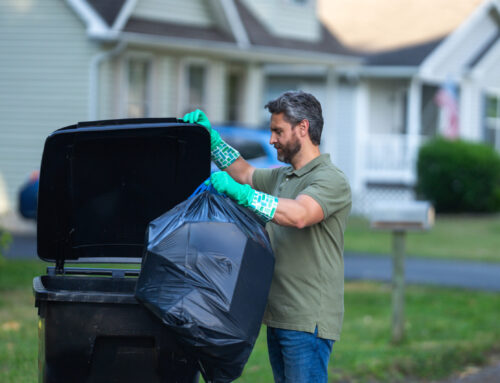
Garbage collection is an integral part of modern life, but for most people, it’s something they seldom think about beyond taking the trash to the curb. Yet, the process of collecting, sorting, and disposing of waste is complex and involves various steps to ensure that it is managed in an environmentally responsible and efficient manner. Understanding how waste moves from your curbside bin to its final destination—whether a landfill, recycling facility, or composting plant—can shed light on the importance of waste management systems in maintaining public health, reducing environmental impact, and promoting sustainability.
The Beginnings: Curbside Collection
Garbage collection begins when residents or businesses place their waste at the curb in designated bins. This first step might seem simple, but it is one of the most crucial points in the waste management process. Proper sorting and handling of waste at the curb determine whether items can be recycled, composted, or sent to a landfill.
Different cities and municipalities have various systems for curbside collection. In many cases, waste is separated into three categories:
- General waste for non-recyclable materials,
- Recyclables such as paper, plastics, and metals, and
- Organics such as food scraps and yard waste.
Curbside bins are often color-coded to help residents understand what belongs where, and local governments typically provide educational materials to inform residents of the rules for sorting. For example, plastic bags might not be allowed in recycling bins because they can clog sorting machinery, and food-contaminated items like pizza boxes might also be rejected. Proper sorting helps ensure that waste is handled efficiently and that recyclable and compostable materials are directed to the appropriate facilities.
Collection: The Role of Garbage Trucks
Once waste is placed curbside, the next step in the process involves collection by garbage trucks. Depending on the size of the community, garbage collection may be conducted by municipal workers or contracted out to private companies. The type of truck used will often depend on the kind of waste being collected.
General Waste Trucks
These trucks collect non-recyclable, non-compostable materials that are destined for landfills. Modern garbage trucks are equipped with hydraulic systems that can lift bins, empty them into the truck’s storage compartment, and compact the waste to maximize space.
Recycling Trucks
In communities with recycling programs, specialized trucks collect recyclable materials. These trucks might be single-compartment or multi-compartment, depending on whether the community uses a single-stream or dual-stream recycling system. In single-stream recycling, all recyclables are mixed together in one bin and sorted later at a facility. In dual-stream recycling, residents are required to separate paper from plastics and metals at the curb, which can improve the quality of recyclables but requires more effort from the public.
Organic Waste Trucks
In areas that offer composting services, organic waste is collected separately. This material is destined for composting facilities where it is transformed into nutrient-rich compost instead of being sent to a landfill.
Garbage collection routes are carefully planned to minimize fuel consumption and reduce the environmental footprint of collection trucks. Trucks usually have set schedules, and drivers are trained to follow efficient routes to avoid unnecessary travel.
Sorting and Processing: What Happens at the Facility
After collection, the real work begins. Depending on the type of waste, it is taken to different facilities for sorting and processing.
Landfills
General waste that cannot be recycled or composted is taken to a landfill. Modern landfills are highly engineered facilities designed to minimize environmental harm. They are lined with protective barriers to prevent harmful chemicals from leaching into the soil and groundwater. Waste is compacted and covered with soil or other materials to reduce odor, deter pests, and limit the emission of methane gas, a potent greenhouse gas that contributes to climate change.
Recycling Centers
Recyclable materials are transported to material recovery facilities (MRFs). At these facilities, recyclables are sorted by type—plastics, metals, glass, and paper—through a combination of manual and automated processes. Powerful magnets extract metals like steel, optical sensors sort plastics, and air jets separate lightweight materials. Once the materials are sorted, they are baled and sent to manufacturers who can process them into new products.
However, contamination in recycling streams can create significant problems. Non-recyclable items mixed in with recyclables can damage sorting machinery or result in entire loads being rejected and sent to a landfill. This highlights the importance of proper sorting by residents at the curbside level.
Composting Facilities
Organic waste collected separately is taken to composting facilities, where it undergoes a process of aerobic decomposition. In controlled conditions, microorganisms break down organic material into compost, which can be used to enrich soil. Composting not only diverts waste from landfills but also reduces methane emissions, as organic waste decomposes anaerobically (without oxygen) in landfills, producing methane.
Reducing the Impact of Waste: Recycling and Composting
The ultimate goal of waste management systems is to reduce the amount of waste sent to landfills. Recycling and composting play vital roles in this effort. Recycling helps conserve resources, reduce the energy needed to produce new materials, and lower greenhouse gas emissions. For example, recycling aluminum cans saves up to 95% of the energy needed to produce aluminum from raw materials.
Composting also provides environmental benefits by returning organic material to the earth and reducing methane emissions. Communities that offer curbside composting programs often see significant reductions in landfill waste, as food scraps and yard waste make up a large percentage of household trash.
Waste-to-Energy: An Alternative to Landfills
For non-recyclable waste, some communities have adopted waste-to-energy (WTE) systems as an alternative to landfills. WTE facilities burn waste to generate electricity or heat, offering a way to recover energy from materials that would otherwise be landfilled. While this process does result in some emissions, it can be a more sustainable option compared to traditional landfills, especially when combined with rigorous recycling and composting programs.
The Role of Technology in Modern Garbage Collection
Technology is increasingly playing a role in making the garbage collection process more efficient and sustainable. Smart waste bins equipped with sensors can notify collection services when they are full, reducing unnecessary pickups and saving fuel. GPS and route optimization software help garbage trucks minimize travel distances, reducing carbon emissions.
Moreover, advancements in recycling technologies allow for the recovery of more materials and the improvement of sorting processes. Some facilities are even exploring artificial intelligence (AI) systems that can identify and sort waste more accurately than traditional methods.
The Importance of Responsible Waste Management
The journey of waste from curbside to landfill (or recycling facility) is a complex and essential process. Garbage collection services not only keep communities clean but also play a crucial role in promoting sustainability, reducing landfill use, and conserving valuable resources. Understanding the steps involved in garbage collection—from sorting at the curb, to processing at various facilities, to the ultimate disposal of waste—highlights the importance of responsible waste management in preserving the environment for future generations. Contribute to a more sustainable future today by calling AAA Sanitation & Garbage Removal!
AAA Sanitation & Garbage Removal
79 Business Dr Ste A
Hull, GA 30646
(706) 543-7788
https://aaasanitationco.com/






Leave A Comment